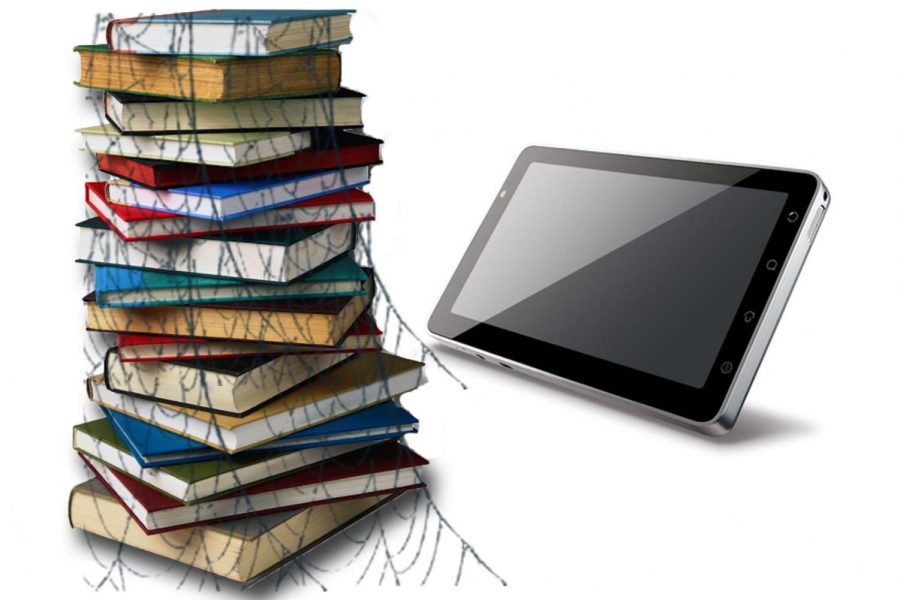Why millennials hate technology and love books
$200, 4.8 pounds. The price and weight of an average textbook in today’s world. While textbooks may seem like an old-fashioned, outdated tool for the classroom with rapid advancing technology and students becoming more social-media-savvy every second, most teens are willing to pay the price (and carry the weight) to keep textbooks in their curriculum.
Speaking from personal experience, I believe that paper is an absolute necessity in the classroom. Since my junior year of high school, every single one of my classes has utilized some sort of online component to aid with classwork, homework, study tools, etc. From Google Classroom to Microsoft Teams to Schoology to Study Sync to Web Assign, keeping up with every program, portal, and password for each teacher’s preferred online tools is exhausting. Frequent homework assignments requiring posts on social media seem inappropriate and out of context in the classroom, even for an avid Twitter user like myself. Late nights of homework are spent staring at a screen – the last thing I’d like to be doing after a long day, especially when I could be writing on paper or flipping through the pages of a real textbook. Tired minds wander, and with unlimited access to any distracting entertainment platform always just one click away, productivity is at huge risk of being completely lost with a simple ‘Ctrl + T.’ Not to mention, writing out notes and worksheets has always been very effective for me as a kinesthetic learner – having to complete everything from flashcards to math problems online takes this opportunity away. Plus, getting ahead on homework every spare second of the day – in the car, at the lunch table, at the ice rink – has been a vital part of my time management and my ability to maintain good grades with an extremely busy schedule. Now, having to wait until I am home with access to a charged computer and sufficient wi-fi to even begin my homework, my workload efficiency has been halved.
‘Stop being dramatic, the screen-time spent on your cell phone will never add up to the hours doing homework at a computer.’ ‘You’re a millennial, technology is in your DNA, why aren’t you celebrating this?’. If these thoughts are crossing your mind right about now, you’re right: the ‘cell-phone-glued-to-hand’ epidemic has taken the world by storm and changed the lives of modern children and adults alike, and has undoubtedly becoming a vital aspect of our culture’s communication, ethics, and daily functions. Despite this, sending a snapchat and learning Calculus are concepts that couldn’t be more different, and there’s overwhelming amount of scientific data to prove that social media posts and academic pages have no reason to share the same digital platform.
Straight from the headline of Michael Schaub’s Los Angeles Times article “92% of college students prefer print books to e-books, study finds,” along with an endless influx of other polls and scientific trials with results against online textbooks that pop up with a simple Google search, it is clear to see that an overwhelming majority of students share my views on the true inconvenience the supposed ‘ever-so-convenient’ online learning. In National Public Radio’s article titled “Attention, Students: Put Your Laptops Away,” experts Pam A. Mueller of Princeton University and Daniel M. Oppenheimer of UCLA found their data of three trials in which hand note-takers highly outperformed computer note-takers to be “suggestive evidence that longhand notes may have superior external storage as well as superior encoding functions.” Computer use may even be putting the health of our youth at risk: according to Gary Heiting, OD’s article “Kids, Computers, and Computer Vision” on allaboutvision.com, “All digital devices with viewing screens emit significant amounts of blue light which might increase a child’s risk of macular degeneration later in life” and “the added exposure to blue light kids receive from these devices and how close these electronic screens are to a child’s eyes for hours each day have many eye care providers worried about potential eye damage over time.”
No matter what objections one may make against textbooks (strain of weight on backs, wasting of paper) or for computers (access to information, preparation for technology in future career) the learning handicaps, huge expenses, and data backing the medical risks associated with the digital replacement of textbooks solidify that print learning is still the most efficient method.
Of course, computers are still an extremely beneficial in some situations, even in conducting research for and typing this very article. Computers will continue to advance in our society, whether we like it or not, and will remain to be a vital aspect of all career fields for years to come. In the meantime, there are ways to advance the old-fashioned textbook before jumping straight to tablets and iPads – for example, slimmer, multi-volume textbook versions may be more effective in cutting the weight, cost, and inefficiency of traditional textbooks that stuff a course’s full year of information into a single binding.
I urge us all, especially students and teachers, not to get ahead of ourselves. Learners in today’s classrooms are the future leaders of our world – before we throw the latest and greatest technology in their young hands, we must remember where the greatest scholars of our time came from, and how we can better modern learning by sticking to timeless principles.





